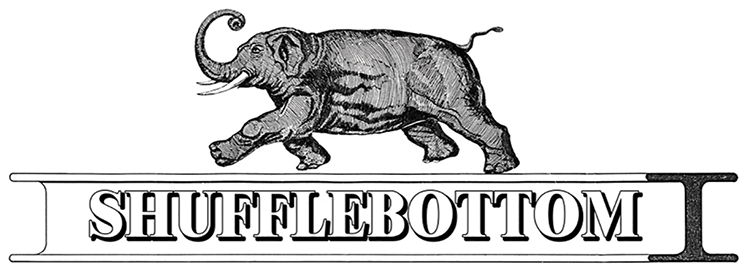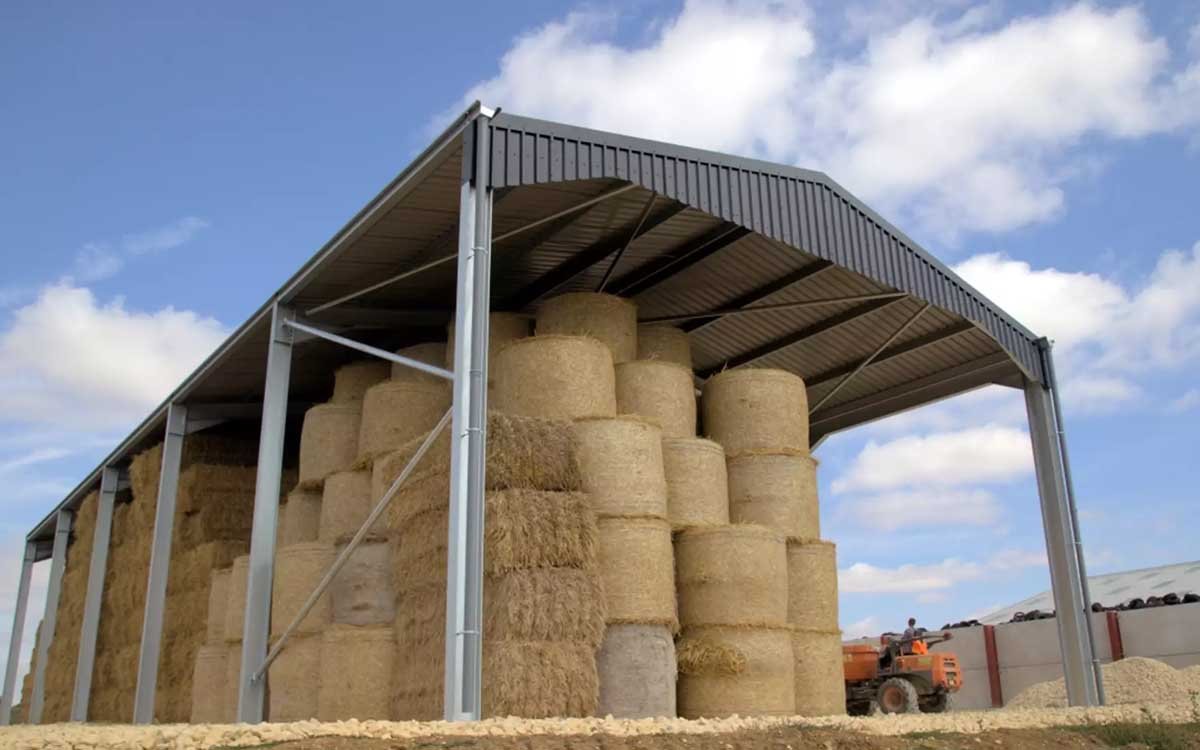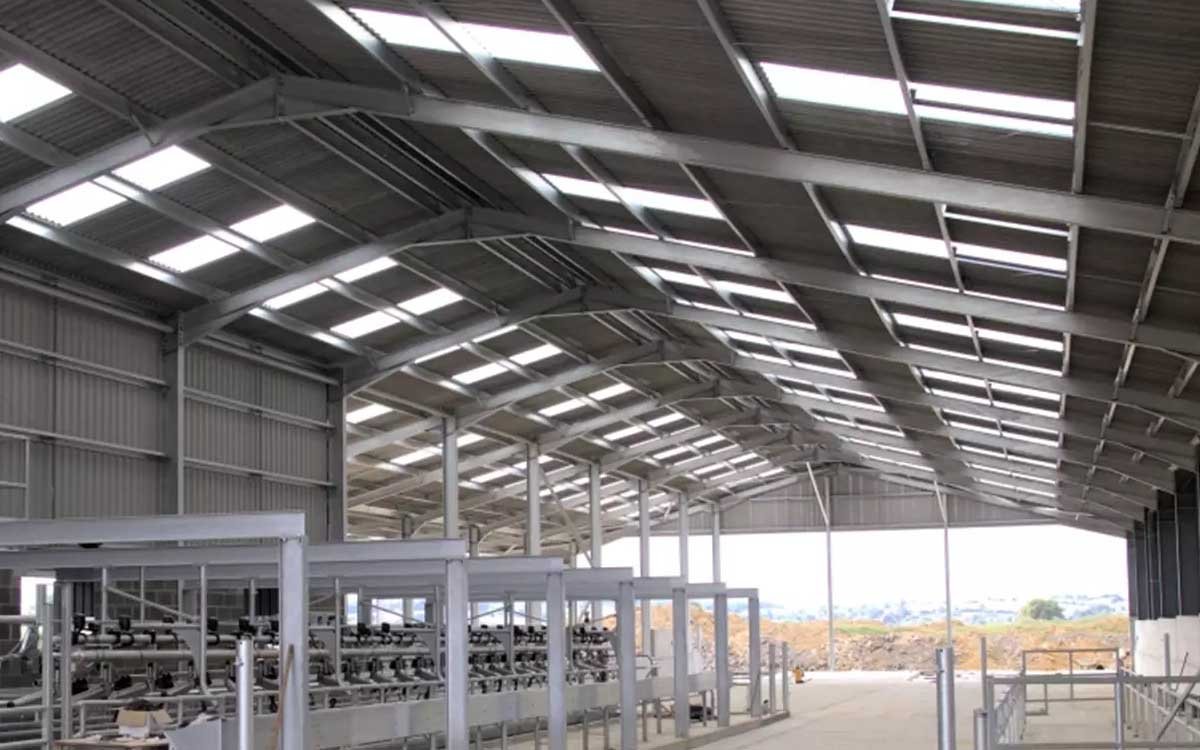New Buildings on Expanding Dairy Farm Express Confidence in Future
Harry Barnes (21) has his dairying future all mapped out on a five-acre site of levelled Leicestershire ironstone, at Somerby south of Melton Mowbray.
The buildings complex on the site is surrounded by 400 acres, farmed by the Barnes family since 1941. Harry is the fourth generation to work on the farm, which is managed on the grass paddock, spring-calving New Zealand system.
“We aim for low operating costs,” said Mrs Jane Barnes, Harry’s mother. “That, alongside our cheese contract, is essential for the future of the farm.”
The cheese contract is from the Long Clawson Dairy co-operative, based in the countryside north of Melton Mowbray. Long Clawson, founded in 1911, is the principal producer of Stilton cheese in the world and has recently completed a £7 million expansion project so that exports can be increased. The co-op also makes Leicestershire Red, Shropshire Blue and a range of savoury and fruit blended cheeses, and its growth programme, supported by Lloyds Bank, means that demand for local milk should also grow – and Harry and his parents Jane and Mark are answering the call. For Harry’s older sister Charlotte, the countryside is also important, but she works in equestrianism rather than farming.
The Barnes family are among the 45 members of the Long Clawson co-operative, which takes milk from Leicestershire, Derbyshire and Nottinghamshire only, because Stilton cheese has to be made from milk originating in these three counties.
The new farm complex at Somerby, named Alma Bank Farm, should be fully operational before summer 2019. It will replace the old, much smaller buildings at South Fields Farm in Somerby village, and has its own entrance from a minor road linking Pickwell to Owston. Careful siting below a ridge means that the new buildings are hidden from Somerby. The surrounding grassland is permanent pasture, 80 acres of it on the ancient ridge (or rigg) and furrow patterns made by simple ox-drawn ploughs in centuries past.
The 130 Ayrshire and British Friesian x Ayrshire milking cows now grazing the land will be joined by 100 more before 2019, the numbers recently augmented by a batch of 51 bought-in heifers. The expansion means that the spring calving pattern is complicated this year with 70 heifers -- the purchased batch plus home-reared --calving down in the autumn. While herd expansion is in progress, the aim of maximum milk from summer grass has to co-exist with the temporary bulge in autumn calving.
This summer, the paddocks have suffered from lack of rain and cows have been fed silage from the end of July, leaving a hole in winter rations. Barley straw has been bought in for the youngstock. “We are growing two fields of maize which we hope will fill the winter gap,” says Jane Barnes, “but as we have not done this before, we are unsure of the impact on milk yield and composition.”
The average annual yield from the grass-fed cows is normally 6,000 litres at 4.1% butterfat and 3.3% protein. Harry’s father Mark Barnes – a former Mayor of Melton Mowbay – is a devotee of Ayrshires, praising their combination of good grass conversion to milk, and milk quality. Harry, who studied agriculture at Reaseheath College at Nantwich, Cheshire, and is the present chair of Oakham Young Farmers’ Club, is keen to bring in more Friesian-Ayrshire cross-bred cattle to increase the total yield.
Harry, Mark and Jane work on the farm every day, assisted by two relief milkers, one doing four mornings and the other five afternoons. The additional cows mean a larger milking parlour, a herringbone supplied by Waikato Milking Systems of Hamilton, New Zealand. Herringbone rather than rotary? “It’s a cheaper system to operate,” says Jane Barnes, “it’s simple so there isn’t much to go wrong.”
Simplicity and cost-saving extends to breeding, with bulls – eight on the farm - preferred to AI. Free water is coming from a borehole delivering 4,000 litres an hour, to be stored in a 25,000 litre water tower, and to be used for all drinking and washing down in the yard and buildings. Electricity remains a cost: there are no photovoltaic panels on the farm yet because solar power cannot be stored until it is required.
The milking parlour, 14,000-litre bulk tank, calving area, cow housing, straw storage and visitor education and viewing areas are in a suite of Shufflebottom galvanised steel-framed buildings, erected by Bill Tracey and his team from Dorset-based Tracey Structures, in less than seven weeks. The roof area of the largest building is 1.3 acres, covered with 80 tonnes of P6R fibre cement roof cladding, with rooflights on one-fifth of the area.
The cattle housing, which should be in use constantly between December and February in a normal winter, has Ventair side cladding above concrete panels, for ventilation and protection from the elements.
The two largest buildings are 220 feet long, and just over 110 feet and almost 71 feet wide respectively. The smaller third building is still 80 feet by 20 feet, and all three are 16 feet to the eaves. The eaves beams for the three are the Shufflebottom galvanised integral gutter, incorporated into the galvanised steel frame construction for added strength.
The open-sided galvanised barn on the edge of the site, which has a capacity of 80,000 cubic feet, is 100 feet long, 40 feet wide and 20 feet up to the eaves.
The team from Tracey Structures, working for Wales-based manufacturer Shufflebottom of Cross Hands, has finished on the site, but in late summer 2018 local firm GB Contracting was busy with concreting, digging a channel for slurry to flow to a new lagoon, installing internal walls and floors in the visitor areas, and continuing the work of transforming a former field into the hub of a modern, grass-based dairying enterprise.
Communication with the public is very important to the Barnes family, and Jane has been speaking about the farm for over 15 years. “I speak to all sorts of groups,” she says, “WI, University of the Third Age, Probus, gardening clubs and more. There is lots of interest out there – even though the new complex is not finished yet, I am already taking bookings to come and view the milking and learn about dairying. There’ll be a live link camera projecting onto a large screen in the new visitors’ room, and the window into the parlour will be low enough for people in wheelchairs to see through comfortably.”
Jane takes part in the ‘FaceTime a Farmer’ scheme organised by LEAF (Linking Environment and Farming) and has a Facebook page, Farmer Barnes’ Dairy, for photos and news from the farm. There will be plenty to report as the family’s substantial investment in dairying creates a farm enterprise fit for the next 50 years, with Harry ultimately at the helm.
H N Barnes & Son, the family company which commissioned the build, commented that Shufflebottom was "invaluable in the design and technical planning stages for our project", and that "staff were very professional". In addition, the company was pleased with customer service.
"All our sheds were bespoke, made to a very high specification which we have full confidence in to last for many generations. We'd be more than happy to recommend Shufflebottom to anyone looking to build a new agricultural shed," the company concluded.


